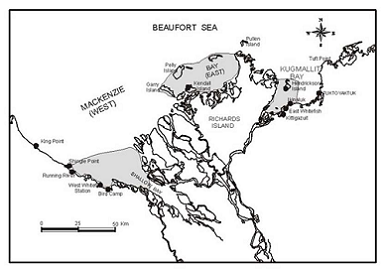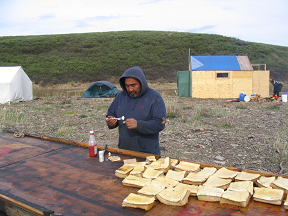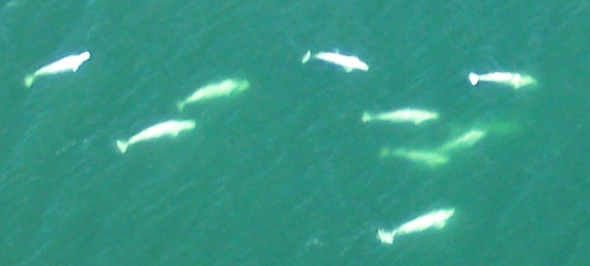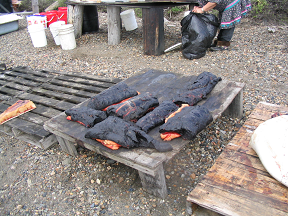Harvest
Subsistence harvesting of beluga whales has been occurring for hundreds of the years in the Mackenzie Estuary area. In historical times, two groups of people lived in this area, the Kupugmiut (300-400 people) and the Kittigaryumiut (800-1200 people). These two groups shared a common whaling ground in Kugmallit Bay and likely lived as separate groups during the winter months. Beluga were an important part of the diets of these two groups (an estimated 25-50% of their year-round diet) and it is estimated that an average of 150 beluga were landed each year with possible highs around 300. In the early 20th century, the subsistence harvest continued, but the size of these harvests are not well documented. They are believed to be higher than at present because whale meat was used to feed dog teams and many hunters had very large dog teams. During this period, most whaling was done using "whale" boats, small clinker-built craft left behind from the whaling ships that hunted out of this area in the late 1800s and early 1900s. By the 1940s and 1950s, the preferred whaling vessels were 10-12m gasoline or diesel-powered schooners.

In recent times and continuing today, hunters and their families from Inuvik, Aklavik and Tuktoyaktuk, NT, Canada, travel to traditional whaling camps along the Beaufort Sea coast once the ice has opened up. They stay in these camps for four to six weeks, hunting as weather and beluga availability permit. Most of the harvests in these areas occur during the month of July. Inuvialuit from Paulatuk, Ulukhaktok and Sachs Harbour also hunt beluga when the whales come close to shore near these communities, usually in late July and in August.

The combined landed harvest of beluga whales from the shores of the Beaufort Sea and Amundsen Gulf averaged 134 animals per year between 1970 and 1979, 124 per year from 1980 to 1989, 111 per year from 1990 to 1999, and 97 per year from 2000 to 2009.
DFO assessed the stock as stable and the harvest as sustainable in 2000. This assessment will be updated in 2016. The struck-and-lost ratio is low, believed to be less than five per cent. This stock is also hunted during the spring and fall migrations by residents of some coastal villages in Alaska (including Diomede, Kotzebue, Kivalina, Point Hope, Wainwright, Point Barrow and Kaktovik). These harvests are also small and dependent on the whales coming close to shore in areas where they can be hunted. Harvests of this stock in Russian waters during the winter have been low since 1990, probably not exceeding 20-30 beluga in a given year.

Papers
L.A. Harwood, P. Norton, B. Day & P.A. Hall. 2002. The harvest of beluga whales in Canada's western arctic: Hunter-based monitoring of the size and composition of the catch. Arctic 55(1): 10-20. Click here
L.A. Harwood, M.C.S. Kingsley & F. Pokiak. 2015. Monitoring beluga harvests in the Mackenzie Delta and near Paulatuk, NT, Canada: Harvest efficiency and trend, size and sex of landed whales, and reproduction, 1970-2009. Can. Manuscr. Rep. Fish. Aquat. Sci. 3059: vi + 32p. Click here



